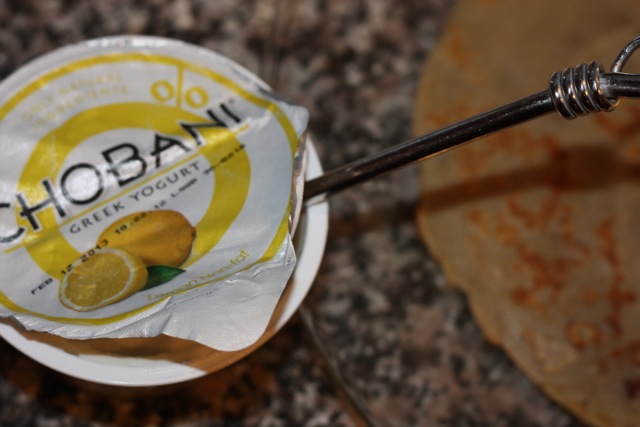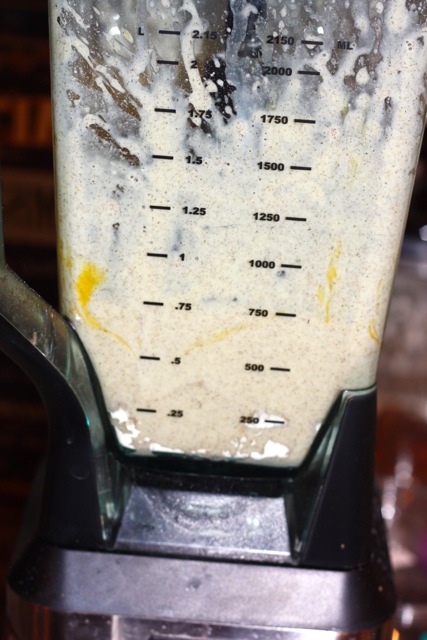I played in the kitchen this morning. I love when I can do that!
This morning, I made crepes. Yum. I am calling these buckwheat crepes because they have buckwheat flour in them…but really they are made with a mixture of gluten free flours. For the wheat tolerant-simply use whole wheat pastry flour or your favorite flour in the recipe.
I decided to fill the crepes with my beloved Chobani lemon Greek yogurt…..just a tablespoon or two…so yum. Chobani is fairly low in lactose about 3-4 grams of lactose in the fruit in the bottom varieties and 4-5 grams in the plain for 6 ounces. Many individuals with lactose intolerance can tolerate up to 4 grams but certainly not every one can… So FODMAPers..since Greek yogurt has less lactose than conventionally prepared yogurt, you may find you have tolerance to small amounts.
I topped the crepes with berries mixed with a pinch of brown sugar and a dash of cinnamon…but certainly you could get fancier and add some fresh basil, mint or ginger.
Not bad right!?
I made the crepes with a FODMAP friendly flour blend I created when I made homemade graham crackers. Did you see that post? Homemade grahams are really fun to make…one of my favorite recipes on my blog. Click here for blog on how to make my FODMAP friendly flour blend and grahams.
I blended the crepe ingredients in my infamous ninja blender. Just toss in all the ingredients and blend away. How easy is that?
Growing up, my mother really got into crepe making….so much so, that really we were inundated with crepes. It’s funny when you can think back to when your mom goes on a cooking spree with one thing. I asked my kids today what they think I make ALL the time…and the answer: Chicken! Ha!
Let your taste buds take a trip to Paris and make these very easy crepes.
Buckwheat Crepes and Berry Bruschetta (FODMAP friendly AND wheat version)
Ingredients
- 1/2 cup FODMAP friendly flour blend {see post that links to my flour blend or use your favorite} (wheat tolerant people use all-purpose flour, whole wheat pastry flour or buckwheat flour OR mixture of them)
- 2 teaspoons granulated sugar
- 3/4 cup lactose free milk
- 2 eggs
- 1 1/2 Tablespoons melted butter
- 1 tsp vanilla extract or paste
- Berry Bruschetta:
- 1/2 cup strawberries and blueberries (I used frozen that I defrosted)
- Pinch of brown sugar
- Dash of cinnamon
- 1-2 Tablespoons Chobani vanilla or lemon yogurt
Instructions
- Place crepe ingredients in blender.
- Blend for about 1-2 minutes.
- Let sit for about 15 minutes and then start cooking!
- Berry mixture-simply mix berries with brown sugar and cinnamon. Could add some fresh mint or basil if feeling especially creative.
- To cook crepes-add a drizzle of oil in a medium size non stick skillet and heat over medium heat.
- Add about 1/4 cup to 1/2 cup of crepe mixture and move pan so that it evenly fits into the bottom. Should be very thin layer.
- Cook for about 1 minute and then very carefully turn.
- Put a little yogurt on the inside of crepe, fold over, top with berries and perhaps a sprinkle of confectioner's sugar.



Hope Kerrigan
I have recently been diagnosed with SIBO via breath tests and my GI doctor sent me for nutritional counseling. My counselor was very informative and gave me a lot of information (including yours) and told me that you had a blog if I had any further questions. (She said that you were “the authority.”) I do have a couple that weren’t made clear to me on my visit.
She gave me several lists that have foods suitable on a low-fodmap diet and foods to eliminate. In looking over all of them and some other internet research… some of the lists don’t “jive.” I know I can’t have cabbage but I was told that I could have sauerkraut. That’s great… because I LOVE sauerkraut but I’m also confused. If my problem is related to carbohydrates that have fermented in my large bowel… why is it that it’s okay to eat fermented foods?
Also, which kind of capsicums am I allowed to have? All, some? I’ve seen them listed on both the “allowed” list and the “eliminate” list.
I hope you will be able to answer my questions and I thank you very much!
P.S. I should also mention that I am both fructose and lactose intolerant.
katescarlata
Hi Hope,
Glad you stopped by my blog! Not sure that I am the ‘authority’ but that is quite a nice compliment! 😉
Common cabbage actually just got the green light–so you can have it. I know it breaks all the typical rules that we think about cabbage–but I have heard from many individuals that they can tolerate it! So maybe give some a try! Sauerkraut probably would be okay too unless it was made with ingredients that contain FODMAPs such as onions. I haven’t experimented too much with sauerkraut with my clients as cabbage is just newly added to the low FODMAP diet. Food that is fermented can be problematic in some individuals but just because a food is fermented doesn’t mean it will contribute to symptoms or add to fermentation in the body–at least to the best of my knowledge! Foods that are fermented by bacteria such as yogurt actually have the potential to have less FODMAPs as the bacteria break them down in the process called fermentation. Probably all capsicums are okay–the Monash app lists both red and green as low FODMAP. In some literature it appeared that green peppers/capsicum might have polyols but Monash has them as low in polyols( and they are truly the authority!) The diet is still evolving so there are various lists out there–even mine needs some slight updates…if only I had an extra day in the week 🙂
If you have an iPhone, iPad or iPod touch–I would recommend you download the newly released Monash Low FODMAP diet app.
Additionally, with SIBO–be sure to space your meals out –3-4 hours between ideally to allow adequate cleansing waves of the small intestine–which only occur with adequate ‘fasting’ between meals.
Hope Kerrigan
Kate–Thank you SO much for your prompt reply. Good information. I do have a few Kmore questions that I haven’t been able to find any answers for and I will put them together in a concise manner the next few days. Also, I don’t have an I-Phone, Pad, etc. and I couldn’t download the Monash diet app. However, I did go to the website and I don’t find cabbage listed there as a low FODMAP. Do you have an updated list from Monash that you could share? Also, you have coconut listed on your Grocery List but in your Today’s Dietician article, you list it as rich in FODMAP’s. I don’t eat much coconut but I do love pure coconut water. Is that okay? One last thing… can you give me a substitute for sour cream to use in cooking? Again, many thanks!
katescarlata
Hi Hope! The FODMAP diet is still evolving and as more foods are tested-we learn more and more about their FODMAP content. So…there remain many grey areas. Common cabbage was added to the low FODMAP safe foods in the latest low FODMAP booklet edition 3 and also noted in the app as a low FODMAP choice. I need to update my current check list but I want to circle back with one of the Monash researchers before I update it…and they are on holiday break at this time. Regarding the discrepancy in some of my older writing–coconut was considered a source of excess fructose so originally was on the High FODMAP list. But as new foods are tested with more accurate and up to date equipment–we are learning more. Coconut, coconut water and coconut milk are now allowed on the low FODMAP diet–as more recent analysis revealed they are not a source of FODMAPs. Although the limit for shredded dried coconut is <1/4 cup. For a sour cream substitute...How about a spoon of plain Green Valley yogurt if you live in the US or I believe in the UK and Australia--> brands such as Lactofree or Liddel’s lactose free yogurt would be good options. Even small amounts such as 2 TB of Greek plain yogurt could be a good substitute for sour cream. In this amount, the amount of lactose would be very small. Always check that yogurts do not have added inulin or FOS–they are adding these fiber additives to so many foods and they are FODMAPs…so beware!!
katescarlata
Somehow my shredded coconut cut off didn’t show up on my response…it is less than 1/4 cup.
Liz
Hi Kate, I have been very slowly incorporating new allowed-carbs after the elimination phase and have been able to tolerate some corn and oat products. I happened to look into rice and was interested in the latest on the whole “arsenic story,” to which I had not been paying close attention–hoping it was hype– up until today when I was thinking of giving it a trial. I read a good article, posted only one week ago, by UC Health called, “Arsenic and Old Rice,” which detailed the research done by both Consumer Reports and the gov’t. It was pretty scary stuff! 🙁 Beyond rice itself, so many gluten-free products have rice flour…I’m thinking I don’t want to have anything to do with rice until the R&D people come up with a better way to grow it! I imagine a little here and there, especially the kind from California, may not be a big problem, but the issue is a bit concerning. What is the consensus in the RD community at this point? As always, many thanks for your time and everything you do on this blog! Best wishes for a wonderful 2013.
katescarlata
Liz,
I think you bring up a very valid and important point for FODMAPers and individuals on a gluten free diet. It is a bit concerning the rice and arsenic issue and I think less is more is a good stance to take when it comes to rice. It’s hard to completely eliminate but trying other grains such as buckwheat, quinoa, oats, oat bran…Moderation is all things. Thanks for sharing your thoughts on this important topic.
Samantha
Please help me! I am so confused! Is soy milk low fodmap? Some sites/bloggs etc say it isnt and some say it is and then some say it depends on how it is made! I have noticed some brands use whole soy beans (8-12%) and others soy protein (3.5%) as listed in their ingredients list. Whats the difference? And is one low fodmap then?
katescarlata
Hey Samantha– The low FODMAP can be very confusing…believe me…you are not alone! The Monash low FODMAP booklet says, “Soy Milk made from ‘whole soybeans’ tend to be high in FODMAP-GOS, soy milks made from ‘soy protein’ tend to be lower in GOS.” The Monash app has soy milk made with soy protein allowable in a 1 cup portion. Hope that helps. So look for soy milk that list only soy protein in the ingredient list NOT whole soybeans.
Samantha
Great thanks so much for that! I’m in New Zealand and I would like to get my hands on that booklet. I see I can order the book from Monash website but the book only costs $10 yet the postage is $15!!! Thats a $25 booklet!!! Any help or ideas on how I can get one cheaper?
katescarlata
Samantha-I was provided a link from the Monash team for a reduced fee shipping rate but that link seems to be no longer working. The researchers should be back from their holiday break and I can learn more about the potential for getting the link and reduced shipping rate back. In the meantime, they do have app called the Monash University low FODMAP app so perhaps you have access to an iPhone, iPad or iPod touch to download it?
Samantha
I have a smartphone but I did read that they will be bringing an app for smartphones sometime early this year. If you could let me know as soon as you find out about this cheaper postage would be greatly appreciated!
katescarlata
The android version of the app is due sometime this year–I believe in the next few months.
Hope Kerrigan
Kate–I don’t have access to an IPhone, etc. Is the information in the booklet as up-to-date as the ap? That is my concern in ordering the booklet. Since things change so rapidly, I’m afraid it will be out-of-date before I even receive it. Thoughts?
katescarlata
The booklet is pretty up to date. They did expand the list a bit, but I still think the booklet is a good purchase if you can’t get the app.